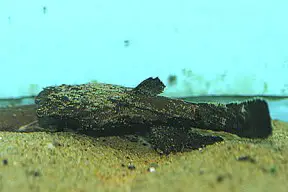Chaca bankanensis
Chocolate Frogmouth Catfish
Classification
Chacidae
Distribution
Malaysia, Indonesia, Brunei.
Habitat
It occurs in rainforests, in shallow, shady waters where it lies hidden amongst leaf litter and mulm.
Maximum Standard Length
8″ (20cm).
Aquarium SizeTop ↑
This species does not require much space for its size. An aquarium measuring 36″ x 12″ x 12″ (90cm x 30cm x 30cm) – 80 litres is adequate for a single specimen.
Maintenance
A dimly-lit tank suits this sedentary species. The use of a soft, sandy substrate is also recommended, as the fish often bury themselves. Most plants will not do well in such conditions, but tolerant species that grow attached to decor, such as java fern and java moss can be used. The addition of some beech twigs and dried leaves will help to simulate the natural habitat of the fish.
Water Conditions
Temperature: 72-79°F (22-26°C)
pH: 6.0-8.0
Hardness: 3-10°H
Diet
It is sometimes possible to wean young specimens onto dried or meaty frozen foods. However, many specimens refuse anything but live food. Small fish, river shrimp and earthworms can all be offered.
Behaviour and CompatibilityTop ↑
A highly predatory species, C. bankanensis is best kept alone. It will consume almost any fish that strays close enough to its capacious mouth, and is capable of swallowing prey items almost as big as itself. In large, deep aquaria it may be possible to keep it with fast-swimming species that live high in the water column, but even this carries risks. It can however be kept with others of its own kind with no problems.
Sexual Dimorphism
Males are longer and slimmer than females.
Reproduction
Not known to have reproduced in captivity, but in all likelihood breeding occurs in a similar fashion to C. chaca.
NotesTop ↑
Chaca are unsuitable subjects for the general aquarist, but are relatively popular among lovers of oddball species. This species is very similar in appearance to the closely related C. chaca. However, it is somewhat darker and redder in colour than its relative, and lacks the hooklets that occur on the lips and body of chaca. It is a true master of disguise, and is also known as the angler catfish, due to it’s ability to use its barbels as a kind of lure, using them to simulate the movements of a worm when potential prey approaches. The unwitting prey is attracted to this apparent feast, only to be grabbed in a lightning-fast movement by the catfish.
As such, C. bankanensis is rarely observed moving around the aquarium during daylight hours, though it sometimes leaves its position to forage under cover of darkness. The use of a red light on the aquarium may allow you to witness this. Such is its commitment to camouflage it does not usually struggle even when netted or handled, although it does have the ability to emit a grunting sound when removed from the water.
An interesting fact about Chaca species is that they appear to bring down the pH of the water when kept in confined conditions. There is some debate as to the reasons for this; it may be that the fish have particularly potent digestive juices in order to efficiently digest large prey items, or that they use some kind of chemical to assist in luring prey. Alternatively, the fish may release an acid-containing secretion in order that they taste bad to potential predators, as they do not possess the means to escape quickly. Whichever of these theories is correct, what remains true is that stringent attention to water quality must be paid in aquaria containing Chaca. This is particularly true in smaller volumes of water, in which the chemistry can change more rapidly.



